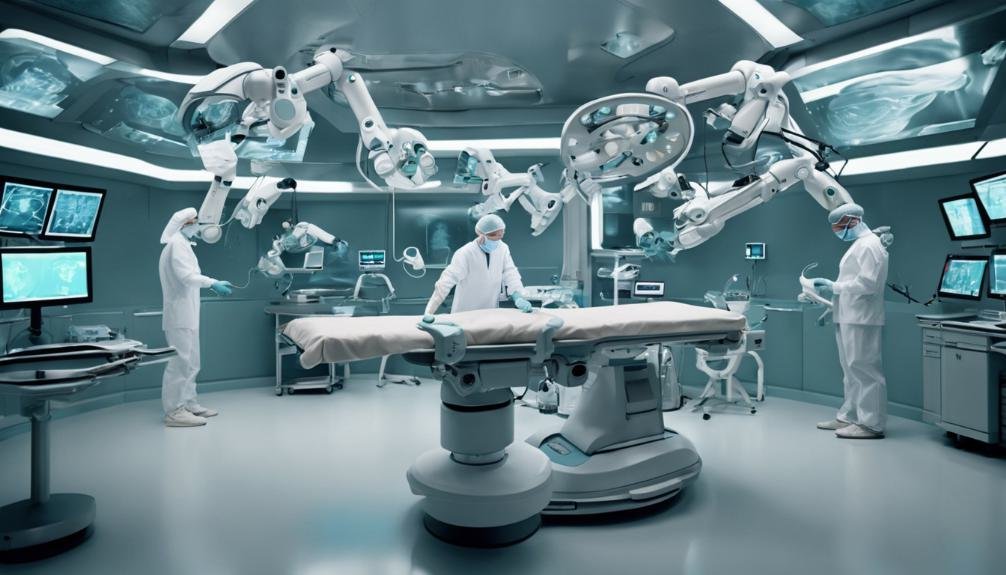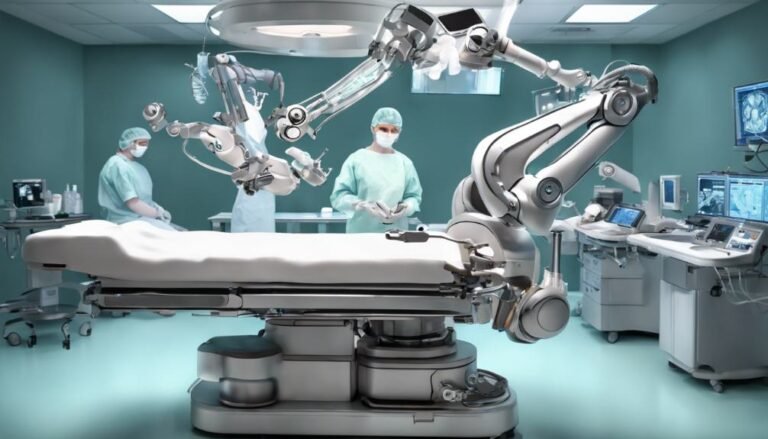AI in Surgery: A Comprehensive Guide
As you explore the domain of AI in surgery, you'll uncover a world where technology is reshaping traditional practices. From the domains of robotic assistance to the domains of predictive analytics, the landscape is evolving at a rapid pace. But what do these advancements mean for the future of surgical procedures? How will AI continue to refine our approach to patient care and outcomes? Join the conversation as we dissect the intricate web of possibilities that AI in surgery presents, and discover the potential for a new era in medical innovation.
Key Takeaways
- AI enhances surgical precision and decision-making.
- Real-time feedback optimizes surgical performance.
- Virtual reality aids in immersive surgical training.
- Predictive analytics improves patient outcomes.
- Ethical considerations ensure patient safety and data privacy.
Evolution of Surgical Robotics
The evolution of surgical robotics has revolutionized the field of surgery through the integration of advanced technology and robotics into medical procedures. Robotic assistance in surgery has provided significant automation benefits, allowing for more precise and minimally invasive procedures.
Robotic assistance offers surgeons enhanced dexterity and precision, leading to improved surgical outcomes and reduced complications. By utilizing robotic systems, surgeons can perform complex maneuvers with greater accuracy and control, ultimately benefiting the patient through smaller incisions, less blood loss, and faster recovery times.
Furthermore, automation benefits such as tremor filtration and motion scaling enable surgeons to perform delicate tasks with steadiness and finesse that surpass human capabilities. These technologies enhance the surgeon's skills, making procedures safer and more efficient.
AI Applications in Preoperative Planning
Utilizing artificial intelligence (AI) in preoperative planning streamlines surgical processes and enhances decision-making through data-driven insights. One crucial application of AI in this phase is surgical simulation. By employing advanced algorithms, AI can simulate various surgical scenarios based on patient-specific data. This enables surgeons to practice and refine their approach before the actual procedure, leading to improved surgical outcomes.
Moreover, AI facilitates patient-specific planning by analyzing a multitude of factors such as the patient's anatomy, medical history, and potential risks. Through machine learning, AI can provide personalized recommendations for treatment strategies, helping surgeons tailor their approach to the individual patient. This level of customization enhances the precision and effectiveness of preoperative planning, ultimately benefiting patient care.
Image Recognition in Surgical Imaging
You can utilize AI for image recognition in surgical imaging to enhance your surgical vision by providing detailed insights into anatomical structures.
With AI algorithms, you can improve image accuracy, aiding in precise identification of critical areas during surgical procedures.
Additionally, real-time image analysis capabilities can assist you in making immediate decisions based on up-to-date imaging data.
Enhancing Surgical Vision
Enhancing surgical vision through advanced image recognition technologies is revolutionizing the field of surgical imaging. Augmented reality (AR) plays a pivotal role in providing surgeons with real-time, enhanced visuals during procedures. By overlaying computer-generated images onto the surgeon's view, AR enhances spatial awareness and enables precision in complex maneuvers.
Machine learning algorithms are employed to analyze vast amounts of imaging data, aiding in the identification of critical structures and anomalies. These algorithms continuously learn and improve, contributing to better decision-making processes during surgery.
Visual enhancements, such as contrast adjustments and highlighting specific anatomical features, further assist surgeons in maneuvering through intricate surgical landscapes with greater accuracy. The integration of image recognition into surgical imaging systems not only enhances the surgeon's ability to visualize internal structures but also reduces the risk of errors and complications.
As technology continues to advance, the synergy between augmented reality, machine learning, and visual enhancements will shape the future of surgical vision and precision.
Improving Image Accuracy
Incorporating advanced image recognition technologies into surgical imaging systems greatly enhances the accuracy of visual data interpretation during surgical procedures. Machine learning algorithms play a pivotal role in improving image accuracy by analyzing vast amounts of data to identify patterns and features that aid in precise image interpretation. These algorithms continuously learn and adapt, enhancing their ability to accurately recognize structures and anomalies within medical images.
The utilization of machine learning in surgical imaging leads to a significant improvement in data accuracy. By training algorithms on diverse datasets, the technology can effectively differentiate between normal and abnormal structures, reducing the risk of misinterpretation. This increased accuracy guarantees that surgeons have reliable visual information during procedures, ultimately improving patient outcomes.
Real-Time Image Analysis
Advanced image recognition technologies enable real-time analysis of surgical images, revolutionizing the accuracy and efficiency of image interpretation during surgical procedures. By leveraging artificial intelligence (AI) algorithms, real-time image analysis in surgery facilitates swift data interpretation, allowing for prompt decision-making and enhancing surgical outcomes.
These AI systems can identify and highlight key structures, anomalies, or abnormalities within the surgical field, aiding surgeons in making informed decisions during operations.
Furthermore, real-time image analysis provides an essential layer of accuracy validation by comparing real-time images with pre-operative scans or databases, ensuring precision in surgical interventions. The technology can detect subtle changes, track instrument placement, and even predict potential complications based on historical data, contributing to improved patient safety and overall procedural success rates.
AI Integration in Real-time Feedback
Utilize AI algorithms to provide immediate feedback during surgical procedures, optimizing decision-making and enhancing surgical outcomes. Real-time monitoring through AI integration allows for continuous assessment of various parameters such as tissue responsiveness, blood flow, and instrument accuracy. By receiving instant feedback on critical metrics, surgeons can make timely adjustments, leading to improved performance optimization and patient safety.
AI algorithms analyze data generated during surgery, detecting subtle changes that mightn't be apparent to the human eye. Through real-time feedback, surgical teams can guarantee precise execution of procedures, reducing the risk of errors and complications. The integration of AI in providing instant insights enhances the overall efficiency of surgical interventions, enabling quick adaptations to evolving scenarios.
Furthermore, AI-powered real-time feedback systems have the potential to standardize surgical practices by offering evidence-based recommendations during the procedure. This not only helps in maintaining consistency across different surgeries but also contributes to the continuous enhancement of surgical techniques.
The utilization of AI in real-time feedback represents a significant advancement in modern surgical practices, revolutionizing the way surgical teams operate and improving patient outcomes.
Predictive Analytics for Surgical Outcomes
Enhance surgical decision-making and patient care outcomes through the application of predictive analytics in surgery.
By harnessing the power of data analysis, predictive analytics offers valuable insights into potential patient outcomes based on a variety of factors. Through the utilization of advanced algorithms, surgeons can make more informed decisions preoperatively, during surgery, and postoperatively.
Patient outcomes are at the core of predictive analytics in surgery. By analyzing vast amounts of data from patient records, imaging scans, and other sources, predictive analytics can help identify patterns and trends that may affect surgical outcomes.
This information allows surgeons to tailor their approach to each patient, leading to more personalized and effective care.
Data analysis plays an essential role in predictive analytics by sifting through complex datasets to uncover meaningful correlations. By leveraging this technology, surgeons can better predict potential complications, adjust surgical plans accordingly, and ultimately improve patient outcomes.
Through the integration of predictive analytics into surgical practice, healthcare professionals can enhance decision-making processes and optimize patient care.
Virtual Reality in Surgical Training
Incorporating virtual reality technology into surgical training revolutionizes the way aspiring surgeons acquire hands-on experience and enhance their skills. Simulation technology offers an immersive experience that allows trainees to practice procedures in a realistic virtual environment. This technology provides a safe space for making mistakes and learning from them without risking patient safety.
Virtual reality in surgical training is instrumental in skill enhancement through hands-on practice. Trainees can perform surgeries repeatedly, gaining muscle memory and improving their dexterity. Real-time feedback and performance metrics help identify areas for improvement, enabling targeted practice sessions to enhance proficiency.
The immersive nature of virtual reality simulations also aids in developing decision-making skills under pressure. Trainees can experience high-stress surgical scenarios and learn to make critical choices in a controlled setting. This experience prepares them for real-life operating room challenges, ultimately improving patient outcomes and safety.
Ethical Considerations in AI Surgery
Ethical considerations play a pivotal role in the integration of artificial intelligence (AI) technology into surgical practices. When utilizing AI in surgery, ensuring patient autonomy is paramount. Decisions made by AI systems must align with patient preferences and values, respecting their right to make informed choices about their care.
Transparency in AI algorithms is vital to uphold patient autonomy, allowing individuals to understand how AI influences treatment recommendations.
Data privacy is another critical ethical consideration in AI surgery. Patient information collected and processed by AI systems must be safeguarded to prevent unauthorized access or misuse. Implementing robust data security measures, such as encryption protocols and access controls, is essential to protect patient confidentiality.
Additionally, healthcare providers must obtain informed consent from patients regarding the collection and utilization of their data in AI applications, enhancing trust and transparency in the surgical process.
Future Trends and Innovations
Artificial intelligence (AI) in surgery is rapidly evolving, with future trends and innovations poised to revolutionize the field. AI-driven advancements are enhancing surgical procedures by offering real-time data analytics, predictive modeling, and personalized treatment plans. These technologies enable surgeons to make more informed decisions, leading to improved patient outcomes and reduced complications.
Tech-driven innovations, such as robotic-assisted surgery and virtual reality simulations, are reshaping the way surgeries are performed. Robotics are increasingly being integrated into surgical workflows, allowing for greater precision, dexterity, and control during operations. Virtual reality platforms are being utilized for surgical training, providing a safe and immersive environment for practicing complex procedures.
The future of AI in surgery holds promise for further automation, increased efficiency, and enhanced patient care. As these technologies continue to evolve, the potential for personalized medicine, reduced surgical errors, and optimized recovery times becomes increasingly achievable. Embracing these advancements will indisputably shape the future landscape of surgical practice, ultimately benefiting both patients and healthcare providers.
Conclusion
As you reflect on the transformative impact of AI in surgery, consider the endless possibilities for advancement and innovation in patient care.
How will the integration of artificial intelligence continue to revolutionize surgical practices and enhance outcomes for both patients and healthcare professionals?
With the evolution of surgical robotics, real-time feedback systems, and predictive analytics, the future of AI in surgery holds the promise of personalized medicine and improved patient outcomes.







